Camera
According to Motorola's spec sheet, the phone has the same 10MP rear camera as the Moto X, and it can shoot 1080p video and 60 FPS slow motion video too. The camera uses an RGBC sensor that should improve low light shots. In practice, it does handle low light well, and it maintains detail with decently controlled noise. Colors in general don't pop, in fact colors looked a bit lifeless compared to our Moto X, which isn't known for vibrant photos. We made sure to clean the lens since that greatly affected image quality on the X, but even with a clean lens, things often look a bit washed out (but not every shot, macro shots have bolder colors). This is likely due to image processing in firmware: folks like better than life colors and some high end camera phones like the Galaxy S4 and Lumia boost color saturation as a crowd pleaser. Clearly, Moto isn't doing anything to enhance colors when they should. We'd like to have more color to work with when post-processing with Photoshop. It's not all bad news: images are sharp with good detail, photos aren't oversharpened, and tap to focus/shoot is very quick and burst mode works well.
The Droid Ultra and Maxx have the shake to shoot feature where you snap your wrist twice to wake up the phone and launch the camera app. Once you get a hang of the motion, it's a time saver. The camera uses an improved version of the vanilla Google camera application with a large arc housing settings. You swipe in from the left to bring up settings and swiping from the right takes you to Gallery. Settings are fairly basic with HDR (on/off/auto), LED flash control, touch focus on/off, slow motion video on/off, panorama on/off, shutter sound on/off and Quick Capture (shake to launch the camera app) on/off. You can play with color effects and filters after shooting a photo using the editor, rather than in the camera app before shooting.
Display
The 5" AMOLED display is very colorful and sharp looking, though it's 1280 x 720 rather than full HD. Honestly, with a quality panel at 5", that's plenty enough resolution and pixel density (294 PPI) for very sharp text and crisp images. Colors aren't terribly exaggerated and there's no noticeable color bias so whites look white. This is an RGB stripe display rather than Pentile Matrix, which helps apparent sharpness.
Droid Ultra, Droid Maxx or Moto X?
We do question Verizon's decision to go with a 5" display, and we assume they wanted to differentiate the Droid Ultra from the 4.7" Moto X and HTC One. The display size and overall design make the Ultra as large as the HTC One and Samsung Galaxy S4, losing some of the Moto X's appeal as a big screen phone with a relatively small casing and ergonomic design. In fact, some of you have asked why the Droid Ultra (and even Droid Maxx) exists at all. The answer is that Verizon's Droid line has always been strong in terms of marketing and sales, and Verizon wanted the line to continue. It's still differentiated by its stark, techno and masculine look and the red wallpapers and ominous "Droid" startup sound that we assume appeal to a different set of people than does the Moto X. As for the Ultra vs. Maxx, we'd go with the Maxx for its matte patterned Kevlar finish, doubled storage and bigger battery. But $299 with contract means the Droid Maxx has a maxed out price.
Wireless and Calling
The phone works on Verizon's LTE network and it's a GSM world roamer too. It has dual band WiFi 802.11b/g/n, Bluetooth 4.0 and a GPS as well as the new Miracast wireless display feature.
Call quality was surprisingly average; usually Motorola does an excellent job of voice. Outgoing voice sounded moderately digitized and incoming voice wasn't super clear. It's not a bad voice phone, but it's not as good as the top Verizon competitors or the Moto X on AT&T.
Data speeds on Verizon's strong LTE network were as expected: 10 to 17.6Mbps down and 3.5 to 6.5Mbps up according to Speedtest.net. Those speeds are comparable to the HTC One X and Galaxy S4 on Verizon and are more than adequate for HD video streaming, web browsing, app downloads and using the phone as a WiFi hotspot for a tablet or laptop.
Moto Software
You get all the goodies we loved so much on the Moto X: Active Notifications, Touchless Control and Motorola Assist. The Droid trio adds Droid Zap for wireless photo sharing with other Android devices (you can download Droid Zap for non-Moto phones on the Google Play Store). These three features (not so much Droid Zap) are examples of what smartphones should be doing. They make the phone easier and more fun to use, and they address real problems like driving safely while interacting with the phone, getting info without turning the phone on and using voice to control the smartphone. I prefer these features to some of the showy but less useful features we've seen weigh down other phones (ahem, Samsung).
- Active Notifications show the time and notifications such as new emails, text messages and more on the sleep screen. The notification screen appears when a new item arrives, and it shows when you move the phone. For example, if you take it out of your pocket or pick it up from the desk, you'll see the time and notifications so you needn't press the power button or unlock the phone. You can control what appears on the screen (in the interest of privacy) and you needn't wake the phone to see more info. If there's a new email, drag the email notification up and it will show you a preview of the new message. Motorola says this saves power since most users turn on the screen many times per day simply to check notifications and the time. The Active Notifications screen uses less power and keeps you informed. Once you get used to this feature, it's hard to go back.
- Touchless Control is Moto's name for voice command that's always listening, even if the phone is sleeping with the display turned off. Thanks to Moto's custom CPU for voice processing, it doesn't drain power madly as does Samsung S Voice with the always-listening function turned on. You'll have to preface your command with the phrase "OK Google Now" so the phone doesn't randomly respond to everything it hears. You'll train it to recognize your voice (just in case you and your spouse or co-worker both have Moto Droid or Moto X phones) and you must use the phrase "OK Google Now". I admit I feel a little dorky saying that phrase, but I quickly got over it when I enjoyed asking the phone what time it was when the phone was in my pocket and my hands and eyes were busy playing BioShock Infinite on my PC. Then I set an alarm for 30 minutes... because you know how one loses track of time when playing a fun game. Yes, there are more serious uses like calling someone or composing a text message, and the phone handles natural language queries well even if it isn't as sassy as Siri.
- Motorola Assist is the evolution of the work Motorola has done to automate tasks based on location and activity. The night mode can silence the phone for the hours you specify. It can automatically silence the phone during scheduled meetings. It uses the GPS and motion sensors to determine when you're driving and it enters car mode where it can announce caller's names and read text messages to you.
Battery Life
Motorola quotes battery life in a novel way, rather than stating talk time or video playback time, they simply state the battery will last for 24 hours of average use. Don't get excited: unlike talk time or video playback time estimates, Moto's claim includes screen off time when your phone is idle or in deep sleep. Granted, Motorola's X8 computing platform revolves around saving battery life while enabling some normally battery-killing features like the always-listening touchless control, and they went with a two core Snapdragon and 720p AMOLED display to save even more power, but a heavy phone user won't make it 24 hours unplugged. With light use, it's perfectly feasible, but for those of you who stream lots of YouTube, indulge in 3D games or use the GPS heavily, this is the usual charge it every night when you go to bed phone. In terms of screen-on use time, it falls between the GS4 and HTC One, and runtimes are shorter than the Moto X.
The Droid Ultra has a 2130 mAh Lithium Ion battery that's sealed inside. That's a little bit less capacity than the 2300 mAh Moto X and considerably less than the 3500 mAh Droid Maxx. The phone ships with the usual compact world charger and it does not support wireless charging. You can of course use micro USB based portable battery packs if you need more power on the road.
Conclusion
It's funny that the Moto X overshadows Verizon and Motorola's latest Droid for 2013. They share quite a bit of DNA including processing architecture, Moto's wonderful Touchless Control and Active Notifications, AMOLED 720p display technology and a 10MP rear camera with RGBC sensor. But the Moto X wins us over with its overarching focus on usability. Yes both offer the active screen and always-on voice command features, but where the X focuses on "smallification" of a big screen device and making it comfortable and easy to hold, the Droid Ultra stretches the screen and device size so it no longer has an advantage over its adversaries the HTC One and Samsung Galaxy S4. The glossy finish that looks nasty with grime in less than an hour, and a design that focuses more on continuing the Moto Droid look than comfort and slipperiness hold the Droid Ultra back from the Moto X's intentionally quiet greatness. That said, Verizon values its Droid line, and you'll likely have an easier time finding it in stores and Verizon will probably encourage you to get their exclusive Droid over the cross-carrier Moto X. In the Droid Ultra's favor is a clean Android UI that puts it in good company with both the Moto X and HTC One, snappy performance, great gaming performance thanks to Adreno 320 graphics and excellent build quality.
Price: $199 with 2 year contract, $599 without contract
Websites: www.verizonwireless.com, www.motorola.com
Related:
Moto X Review
HTC One Review
Samsung Galaxy S4 Review |
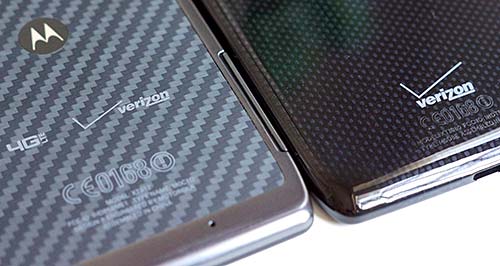
The Moto Droid RAZR and Droid Ultra.
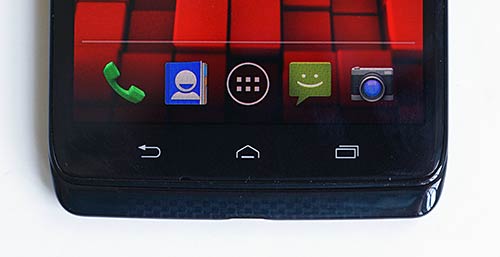
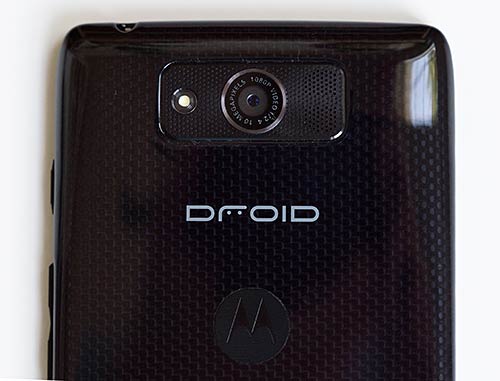
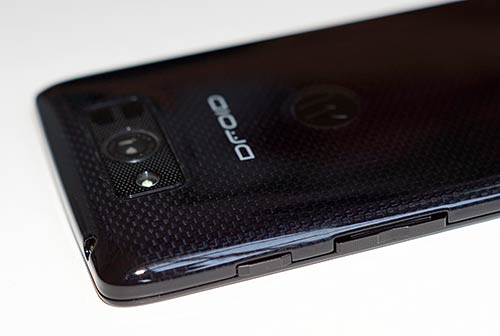
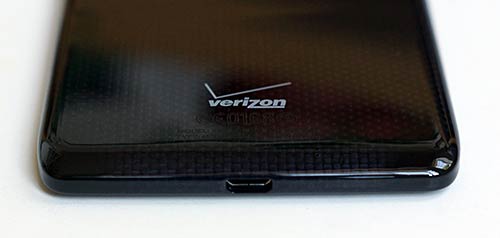
|

